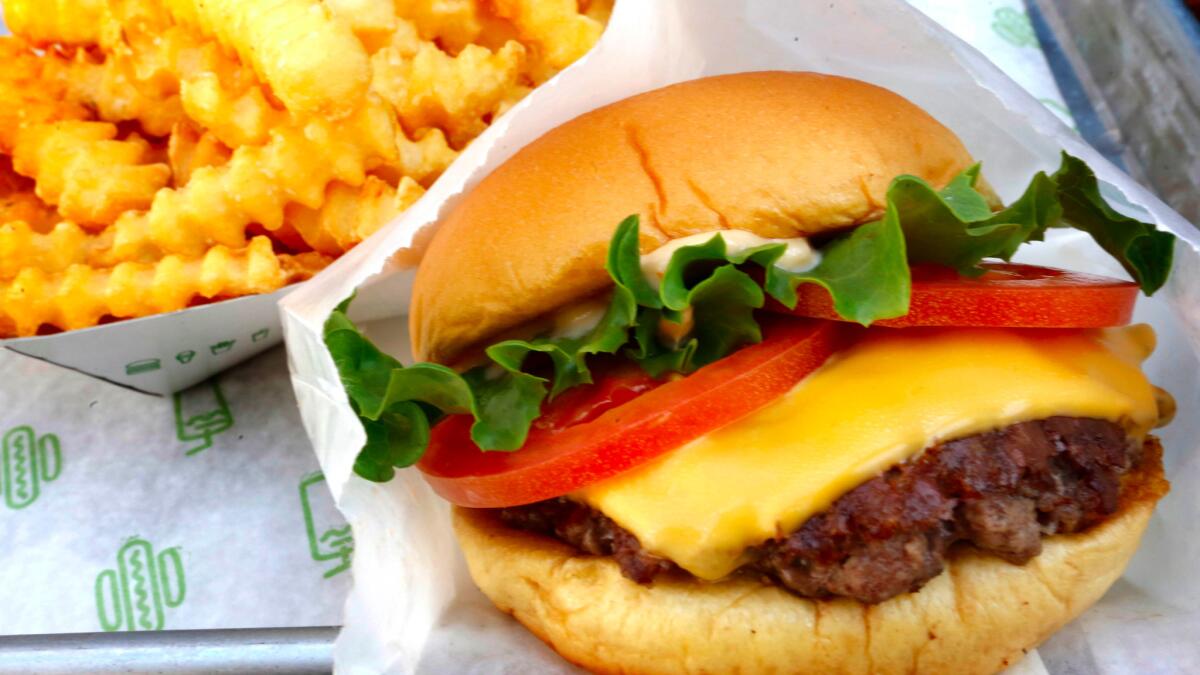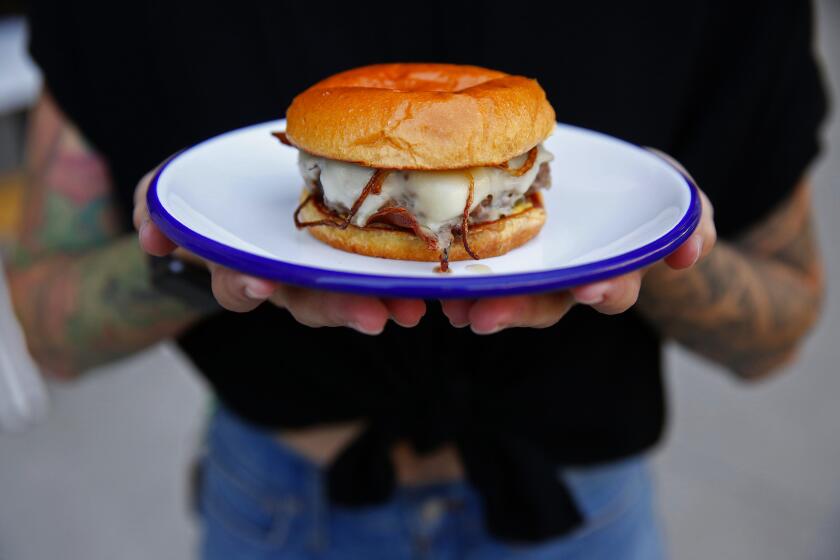Shake Shack will return $10-million loan to small-business rescue program

- Share via
Shake Shack Inc. will return a $10-million loan from the U.S. government amid criticism that the publicly traded burger chain and other larger companies gobbled up the emergency funding while smaller businesses were frozen out.
More than a dozen publicly traded companies with revenue topping $100 million received funds before the Paycheck Protection Program — aimed at rescuing small businesses — ran out of money, according to a Bloomberg review of regulatory filings. Lawmakers in Congress are said to be near an agreement to top up the loan program as well as provide new funds for hospitals and coronavirus testing.
“Shake Shack was fortunate last Friday to be able to access the additional capital we needed to ensure our long-term stability through an equity transaction in the public markets,” said Chief Executive Randy Garutti and Danny Meyer, the founder and chairman of Shake Shack and CEO of Union Square Hospitality Group. The company said last week it sold $150 million of equity and filed Monday to offer as much as $136 million more to underwriters.
“We’re thankful for that, and we’ve decided to immediately return the entire $10 million PPP loan we received last week so that those restaurants who need it most can get it now,” the pair said.
Oversight of the CARES Act was supposed to start immediately. It has barely gotten underway, leaving gaping holes in accountability as hundreds of billions of dollars are set to go out.
Shake Shack has 189 restaurants in the U.S. that employ nearly 8,000 people. It said it is still operating many outlets while closing its dine-in facilities. Union Square Hospitality Group, with more than 2,000 employees, suspended its business in March. Like many big companies, both qualified for the government loans, the statement said, because their outlets employ fewer than 500 workers each.
The sight of big companies getting aid while mom-and-pops complained they’d been frozen out of funding has sparked criticism over who was rescued by taxpayer dollars and who wasn’t.
Shake Shack reported revenue of $594.5 million in 2019. Its sales have grown at least 28% every year since 2013. The company’s outlook has rapidly shifted, however, as the coronavirus has shut much of the U.S. economy. The burger chain warned last week that it’s in danger of breaching the terms of its borrowing agreement as it loses about $1.5 million per week.
Shares of the company opened lower Monday amid a broad decline of U.S. equities, but around 8:20 a.m. Pacific, they were up 7.4%.
Asked whether such large, publicly traded companies should be eligible for PPP funds, President Trump on Sunday spoke about the role of franchisees as small businesses.
“I don’t know much about any of those companies. But a lot of times they’re owned by franchisees, where they own one or two places,” Trump said at a White House press briefing. “So a lot of that would depend on what the formula is.”
Treasury Secretary Steven Mnuchin said on Twitter that he was “glad to see” Shake Shack would return the loan.
Certain branches of Potbelly sandwich stores and Ruth’s Chris steak houses, which also received PPP funds, are operated as franchises. Shake Shack says on its website that it doesn’t franchise.
The PPP was supposed to save our small restaurants and businesses. But where’s the money?
In a statement posted to Meyer’s LinkedIn page and tweeted under his verified Twitter account, the pair of Shake Shack leaders said the U.S. program “came with no user manual and it was extremely confusing.” Shake Shack faced operating losses of more than $1.5 million a week, while the clear language of the legislation allowed restaurant chains to apply for relief.
“Late last week, when it was announced that funding for the PPP had been exhausted, businesses across the country were understandably up in arms,” Garutti and Meyer said. “If this act were written for small businesses, how is it possible that so many independent restaurants whose employees needed just as much help were unable to receive funding? We now know that the first phase of the PPP was underfunded, and many who need it most, haven’t gotten any assistance.”
The U.S. Small Business Administration program, working with almost 5,000 lenders that disburse the loans, approved applications for $342.3 billion in just 13 days, with the rest of the $349 billion going for fees and processing.
An earlier statement from the SBA and the Treasury Department said that the “vast majority of these loans — 74% of them — were for under $150,000, demonstrating the accessibility of this program to even the smallest of small businesses.” But an SBA report showed that about 2% of the firms approved for loans accounted for almost 30% of the funding.
The rapid depletion of the funding shows how businesses are scrambling to survive amid the economic shock of the viral outbreak that has infected millions of people and killed more than 160,000 around the world.
Restaurants are among the businesses hit hardest in the pandemic, and the industry will face major hurdles in getting customers to be comfortable coming back. Same-store sales in the last week of March fell 83% at casual-dining chains and 34% at fast-food restaurants, according to MillerPulse data. April’s declines may be even steeper.
The Associated Press was used in compiling this report.
More to Read
Inside the business of entertainment
The Wide Shot brings you news, analysis and insights on everything from streaming wars to production — and what it all means for the future.
You may occasionally receive promotional content from the Los Angeles Times.











